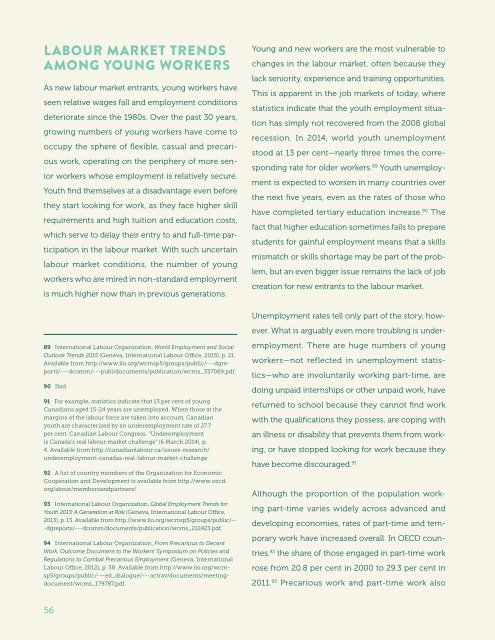YOUTH CIVIC
JieguI2U
JieguI2U
Create successful ePaper yourself
Turn your PDF publications into a flip-book with our unique Google optimized e-Paper software.
LABOUR MARKET TRENDS<br />
AMONG YOUNG WORKERS<br />
As new labour market entrants, young workers have<br />
seen relative wages fall and employment conditions<br />
deteriorate since the 1980s. Over the past 30 years,<br />
growing numbers of young workers have come to<br />
occupy the sphere of flexible, casual and precarious<br />
work, operating on the periphery of more senior<br />
workers whose employment is relatively secure.<br />
Youth find themselves at a disadvantage even before<br />
they start looking for work, as they face higher skill<br />
requirements and high tuition and education costs,<br />
which serve to delay their entry to and full-time participation<br />
in the labour market. With such uncertain<br />
labour market conditions, the number of young<br />
workers who are mired in non-standard employment<br />
is much higher now than in previous generations.<br />
Young and new workers are the most vulnerable to<br />
changes in the labour market, often because they<br />
lack seniority, experience and training opportunities.<br />
This is apparent in the job markets of today, where<br />
statistics indicate that the youth employment situation<br />
has simply not recovered from the 2008 global<br />
recession. In 2014, world youth unemployment<br />
stood at 13 per cent—nearly three times the corresponding<br />
rate for older workers. 89 Youth unemployment<br />
is expected to worsen in many countries over<br />
the next five years, even as the rates of those who<br />
have completed tertiary education increase. 90 The<br />
fact that higher education sometimes fails to prepare<br />
students for gainful employment means that a skills<br />
mismatch or skills shortage may be part of the problem,<br />
but an even bigger issue remains the lack of job<br />
creation for new entrants to the labour market.<br />
89 International Labour Organization, World Employment and Social<br />
Outlook Trends 2015 (Geneva, International Labour Office, 2015), p. 21.<br />
Available from http://www.ilo.org/wcmsp5/groups/public/---dgreports/---dcomm/---publ/documents/publication/wcms_337069.pdf.<br />
90 Ibid.<br />
91 For example, statistics indicate that 13 per cent of young<br />
Canadians aged 15-24 years are unemployed. When those at the<br />
margins of the labour force are taken into account, Canadian<br />
youth are characterized by an underemployment rate of 27.7<br />
per cent. Canadian Labour Congress. “Underemployment<br />
is Canada’s real labour market challenge” (6 March 2014), p.<br />
4. Available from http://canadianlabour.ca/issues-research/<br />
underemployment-canadas-real-labour-market-challenge.<br />
92 A list of country members of the Organization for Economic<br />
Cooperation and Development is available from http://www.oecd.<br />
org/about/membersandpartners/.<br />
93 International Labour Organization, Global Employment Trends for<br />
Youth 2013: A Generation at Risk (Geneva, International Labour Office,<br />
2013), p. 13. Available from http://www.ilo.org/wcmsp5/groups/public/--<br />
-dgreports/---dcomm/documents/publication/wcms_212423.pdf.<br />
94 International Labour Organization, From Precarious to Decent<br />
Work: Outcome Document to the Workers’ Symposium on Policies and<br />
Regulations to Combat Precarious Employment (Geneva, International<br />
Labour Office, 2012), p. 38. Available from http://www.ilo.org/wcmsp5/groups/public/---ed_dialogue/---actrav/documents/meetingdocument/wcms_179787.pdf.<br />
Unemployment rates tell only part of the story, however.<br />
What is arguably even more troubling is underemployment.<br />
There are huge numbers of young<br />
workers—not reflected in unemployment statistics—who<br />
are involuntarily working part-time, are<br />
doing unpaid internships or other unpaid work, have<br />
returned to school because they cannot find work<br />
with the qualifications they possess, are coping with<br />
an illness or disability that prevents them from working,<br />
or have stopped looking for work because they<br />
have become discouraged. 91<br />
Although the proportion of the population working<br />
part-time varies widely across advanced and<br />
developing economies, rates of part-time and temporary<br />
work have increased overall. In OECD countries,<br />
92 the share of those engaged in part-time work<br />
rose from 20.8 per cent in 2000 to 29.3 per cent in<br />
2011. 93 Precarious work and part-time work also<br />
56


